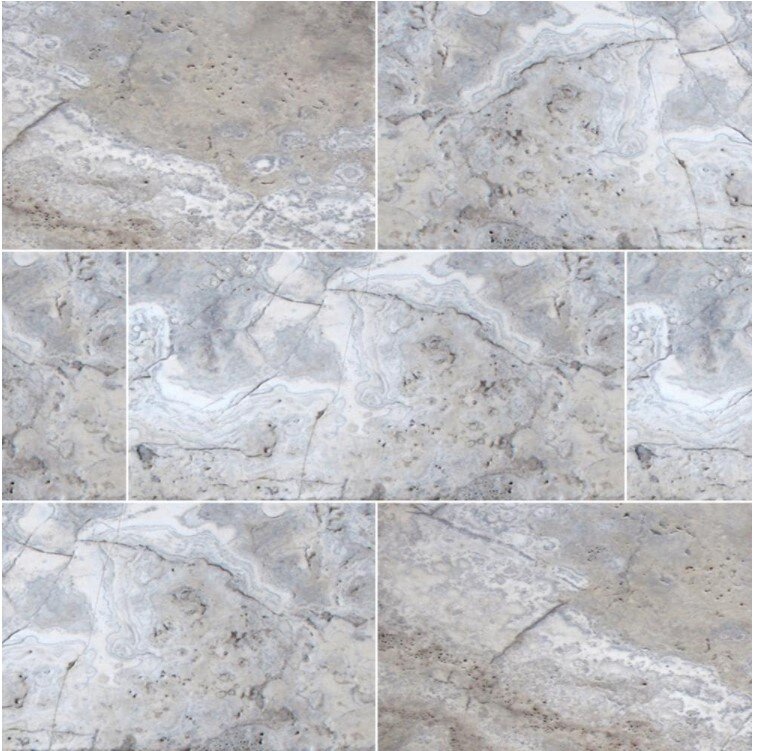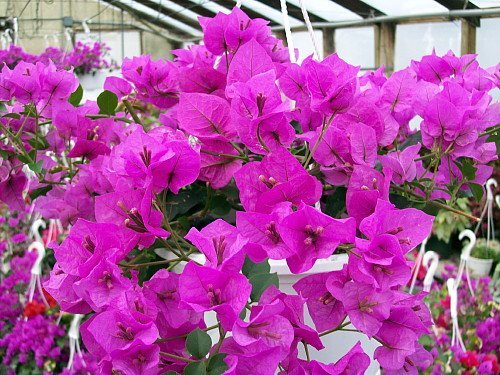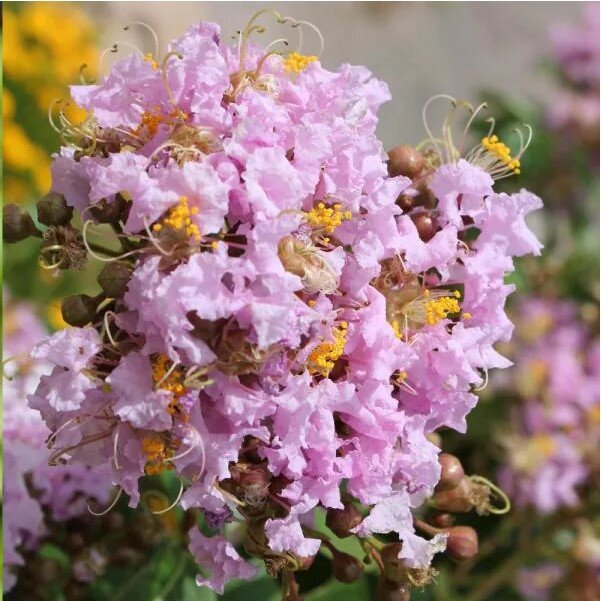Napa Garden Reveal [California-Mediterranean Landscape Design Ideas]
It’s time to reveal the Mediterranean inspired garden that was so long in the making! Complete with bocce court, lavender, succulents, crape myrtles, natural stone pavers, and lots of pea gravel. (Lots!)
It’s my outdoor oasis and I love it, especially after living with the sad state of garden affairs for so long (like 12 years long).
[This post contains affiliate links. Click here to read my full disclosure.]
If you’re curious about my landscape design process, check out my first post on the project: The First Step In Designing A Garden. Keep reading to see the actual landscape plans below.
Below is a bird’s eye view. I drew on a lot of historic garden references from the Moorish Alhambra in Spain to gardens in Southern France, Italy, and Portugal.
As you can see, the garden layout is mostly symmetrical. I aligned it with the view from the kitchen sink inside, a place where I spend a lot of time.
The invisible centerline runs from the main kitchen window through the middle of the patio and bocce court.
The pea gravel is used throughout, with no concrete anywhere. This makes for flexible use of the space.
I used pea gravel throughout my Mediterranean garden. The patio seating area is surrounded by a bocce court and planting beds.
The bocce court looking toward the street is planted with lavender. My house is mostly side yard - the actual back yard is quite small.
[Want more design inspo and helpful plant tips? Let's hang out on Instagram!]
Let’s kick things off with some Before images. “Before” consisted of a lot of cracked concrete driveway, some grass, and lots of overgrown shrubbery. The motely assortment of plants had been languishing for a long time.
View north-west. The large ornamental pear tree was diseased and thought it was fall year-round.
More concrete and grass. Those two potted figs are much happier now that they have new homes in the ground.
The old chicken coop, overgrown raised beds, and part of the patio. The only new element was the recently replaced fence.
Design Elements
After so many years of mentally redesigning while gazing wistfully through my kitchen window, I had a good idea of what I wanted. I had a general layout in my head and specific ideas of how to make a beautiful garden that was also practical and budget-friendly.
(Click to expand) Here’s the Landscape Layout Plan . A layout plan shows where all of the elements will be placed. Design | Greenhouse Studio. Property base plan | Michalski Design Group
Design Constraints
Design constraints are just what it sounds like - things you have to work around. Whether it’s restrictions from city code, budget, or existing elements you need to work around.
I’ve always argued that having design constraints makes for better projects than carte-blanche projects - it forces you to get creative. The end result is often better for it.
[Read more on this in my “design manifesto” post (ha) - How To Design A Room.]
Here were my main landscape design constraints:
Water permeability - my property has some seasonal underground water that floods my basement (like when the sump-pump dies at 11:00 PM on a work night..)
I wanted a permeable surface that allows for water percolation. A permeable surface is better environmentally since it replenishes the aquifer rather than getting routed out to a storm drain.
It also reduces flooding. Urban areas can be 90% or more flood-prone than ag or wild land.
Why? Because urban areas are paved. This means water sits on the surface with no where to go rather than being absorbed by the ground.
The driveway was very cracked. We have a high water table here which contributes to cracked concrete. This was a big part of why I wanted to go with pea gravel instead. Not only does it look beautiful and is inexpensive, it will never, ever crack!
Driveway view “After.” It’s very open to the street which I don’t like, but I decided to hold off on building a stucco wall and gate for budget reasons. (see below)
Budget - I had a budget and stuck to it. I made the choice to remove construction on the east and north sides of the property as well as a stucco wall and security gate from the project scope for now.
This is called “phasing” a project. Plan the entire project but install it in phases as budget or circumstances allow. This is how you avoid ending up with a piece-meal design.
[Read all about how to budget for a remodel project.]
Garden Design Priorities
So enough with the preamble - here’s my list of project priorities and the end results!
Pea gravel - beautiful, permeable, budget-friendly, & won’t ever crack!
Natural stone pavers - same deal. Beautiful and won’t crack - sand-set, not mortared.
Natural shade structure - planted not constructed.
Bocce court - fun and a value-add in Napa.
Mediterranean plantings - drought tolerant and adapted to arid California.
Plant palette - mostly green, white, and lavender + pink.
Pea Gravel “Hardscape”
Pea gravel and decomposed granite are two of the most common surfaces used in traditional Mediterranean style gardens. Study gardens in Spain, France, Italy etc. and you will see a lot of it (and zero turf grass).
Why? It was a readily available material. Acres of concrete and water-thirsty lawns? Nope. Those places had to conserve water too.
Traditional gardens are a wonderful design reference. Had I gone with concrete, it would have cost much more and I wouldn’t have liked the result nearly as much.
There’s no distinction between driveway, parking, and patio since it’s all pea gravel. This makes the space more flexible - I can set up tables and sip wine in the “driveway” for a party, and it doesn’t feel like you’re hanging out in a driveway.
Metal edging
If I can impart one bit of advice it would be to set aside a little extra for metal edging over plastic bender board. There’s no comparison in the finished look. The metal edging disappears whereas plastic bender board jumps out. (See image below)
Stone Pavers
The new walkway and step into the back of the kitchen is silver travertine. It was used on a house in the neighborhood for their pool/patio and I fell in love.
I’ve never been crazy about the beigey color of most travertine, but this warm silvery color makes all the difference for me.
I also saw silver travertine as a practical choice because I wanted a lighter colored stone but was worried about staining. This stone is plenty “busy” with variable colors and natural imperfections, and so far, anything that’s landed on it, from bird poop to berries, has disappeared.
Silver travertine landscape pavers with pea gravel and metal edging for the garden hardscape.
I had the pavers set in sand rather than mortar. Ground water, earthquakes, and teen boys driving over and cracking my lovely pavers are all real possibilities.
I wanted the pavers to be able to shift around a bit rather than crack, and I wanted to be able to easily pop out a paver and replace it if needed.
The silver travertine has a lot of movement and natural variability which helps disguise any staining. The pea gravel is a mixture of cool and warm colored stones. The metal edging keeps everything in place but is almost invisible.
For the planter borders I used a combination of dark granite block and metal edging. The dark gray granite blends well with the pea gravel. The border at the driveway’s approach and in front of the garage is silver granite cobbles set in sand.
I didn’t intend to have a dark gray for the planter border and lighter silver for the cobbles. It was due to a purchasing mix up, and of course, I was all worried about it at first. But like so many things, I don’t give it a thought now, and they look great together.
Silver granite cobbles sand-set, pea gravel, and black granite block with metal edging. I’m trying my best to ignore the oil splotches on the left from my son’s 80’s era car.
SHOP THE LOOK
Natural Shade Structure
I didn’t want to build a shade structure - I rarely think they’re beautiful, they’re very expensive, and they often don’t age well.
The only catch with “natural shade structures”? They require patience! I spent extra to purchase 36” box crape myrtle trees, but they won’t cut the mustard shade-wise for some time yet.
In fact, I broke down and bought two shade umbrellas this season. They look great, but it’s been such a windy year in Napa that they’re often blowing over when open.
I’ve resorted to extra fertilizing and water to encourage faster future shade!
Here’s my Ebay travertine table surrounded by ‘Muskogee’ crape myrtles for dining al fresco.
A travertine table in front and my DIY outdoor daybed in the back. I planted four ‘Muskogee’ crape myrtles for shade rather than build a shade structure.
Bocce Court
In the grand scheme of a significant landscape overhaul, bocce courts don’t cost that much. I live in Napa, CA, a.k.a. Wine Country, so they’re a value-add when well designed and maintained.
It could also basically be swapped out for a single-lane in ground pool, space wise. (Not budget-wise!)
Bocce court August 2020 - two months after installation. This was a fun image to look back on because I could see how much the plantings have grown in just under a year. The lavender and fig are so big now.
Bocce court surrounded by Provence lavender and Venus® Flowering Dogwoods (left). Bocce courts traditionally have a topdressing of oyster flour over the decomposed granite base.
Drought Tolerant Plants
Plants suited to California are often called Mediterranean, but there are several regions in the world with similar climates including parts of Australia, South Africa, and Chile. They’re areas with hot, dry summers and cool, wet winters.
Fortunately, this means we have many beautiful and interesting plants to chose from. When it’s time to do a planting plan, I’m like a kid in a candy shop!
(Click to expand) Here’s the Landscape Planting Plan. I cropped out the plant legend so you could better see the plan itself, but planting plans show the layout and spacing of all the plants and specify plant species and counts for purchasing. Design | Greenhouse Studio. Property base plan | Michalski Design Group
I chose plants that are (mostly) drought tolerant with interesting qualities - whether flowers, foliage, texture, or fruit. Double points if a plant has something to offer during more than one season.
Agave medio-picta 'Alba' (White-Striped Century Plant) is surrounded by pink-flowered Teuchrium chamaedrys (Wall Germander) and ‘Little Bunny” pennisetum grass. ‘Provence’ lavender surrounds the bocce court.
Plantings here are wall germander, boule rosemary, cat mint, kumquat citrus, lavender, and a fig. All are drought tolerant except the citrus. Pandora getting in her usual cameo. (cateo?)
A couple agaves , two of my Dad’s golden barrel cacti, and white and pink Oenothera lindheimeri flank a boulder that came with the house. A sycamore tree and Pennisetum ‘Karly Rose’ line the back and ‘Walker’s Low’ cat mint in the foreground.
I also pushed the envelope of climate-adaptability. Both the bougainvillea and brugmansia (angel’s trumpet) are frost sensitive. They both survive though because they’re up against a south-facing, inset wall which provides insulation when it freezes.
Both suffer some frost damage though that needs pruning in spring. They’re two of my favorite plants from living in southern CA though, so it’s fun to be able to grow them here.
Both bougainvillea and angel’s trumpet aren’t frost tolerant but survive next to a south-facing wall. Rock purslane succulents (bottom right) haven’t yet opened their fuchsia flowers for the day.
Who can resist Brugmansia ‘Charles Grimaldi’ (aka Yellow Angel’s Trumpet)? Not me! Their pendulous blooms smell divine at night, but beware - these plants have their natural defenses - all parts are poisonous!
SHOP THE LOOK
Well that’s my Mediterranean garden reveal. It’s such a joy to finally have a garden I love and watch it evolve over time. After all, a garden is never finished, right?
I hope you enjoyed seeing it. If you have any questions about garden inspiration, materials, or plantings, let me know in the comments below.
[Want more design inspo and helpful plant tips? Let's hang out on Instagram!]
Enjoy the post? Pin it for later!
If you have any questions or comments, please drop me a note below. Be sure to check back for my response (I always respond) since no notification is sent.
XO,
Tina




























